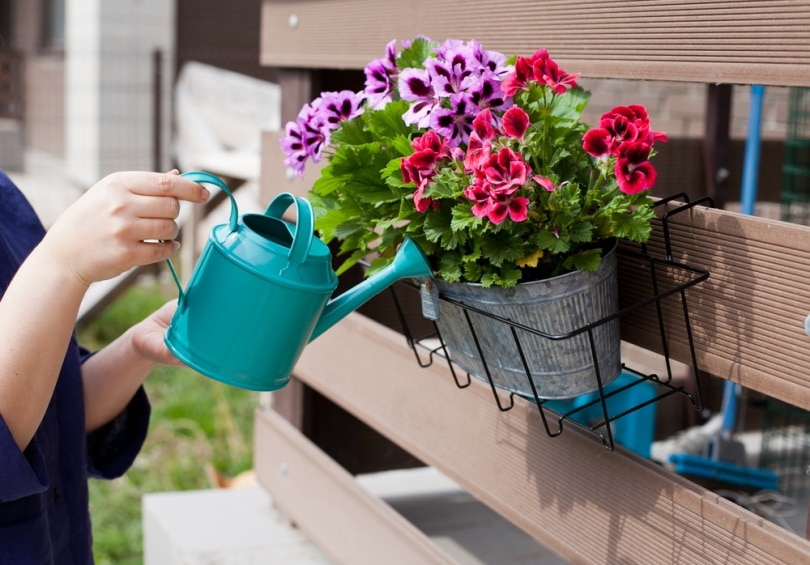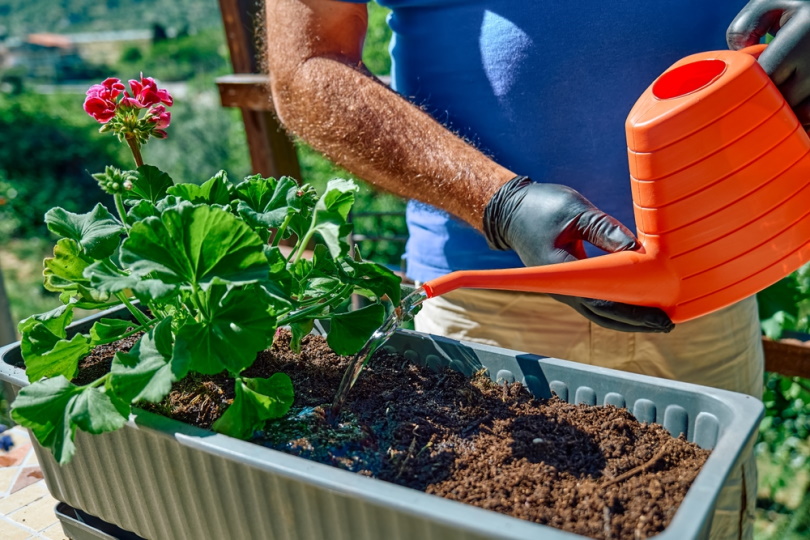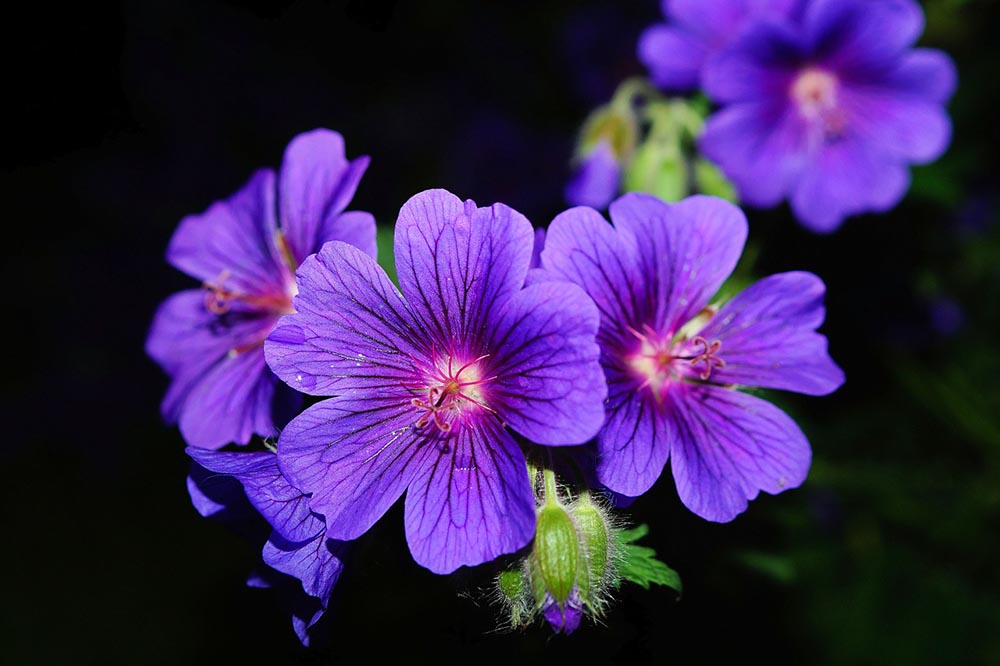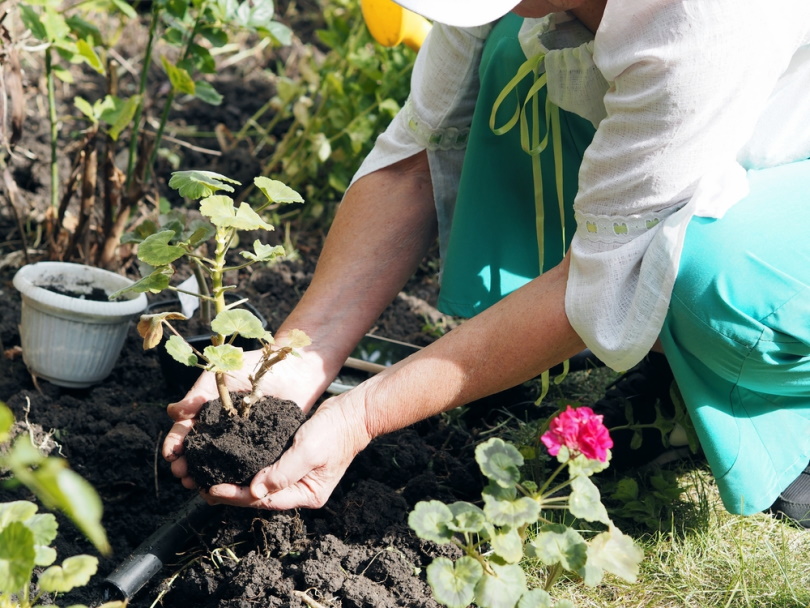How Much & When to Water Geraniums: Care & Propagation
-
Brooke Bundy
- Last updated:

Popular in large pots, hanging baskets, and window boxes, geraniums are a perennial favorite that can survive the winter as an evergreen in zones 9-10. They’re grown as indoor houseplants during the winter in cooler zones or treated as annuals. Originally from South Africa, geraniums are more tolerant of drought than over-watering, and should only be watered when the top two inches of the soil is dry. Over-watering your geranium makes it susceptible to root rot and discolored leaves. Read on to see how to welcome this vibrant bloomer into your yard for the summer.
All About Geraniums

| Common Name | Geranium |
| Scientific Name | Pelargonium spp. |
| Sun Exposure | Full Sun |
| Zone | Grown as a perennial in zones 9-10, or as an annual or winter houseplant in Zones 3-8 |
It’s important to note that what we commonly think of as a geranium is actually a Pelargonium. The confusion came from traders who discovered the Pelargonium plant in South Africa in the 1600s and brought the plant back to Europe, calling it a geranium. A true geranium is a cold hardy plant, dying back in the winter but returning in the spring.
While they may be a pretty summer addition to your garden, you should know that Pelargoniums are poisonous to dogs and cats. This is especially important to know if you’re considering treating your geranium as a houseplant during the winter because you’ll need to put it somewhere your pets can’t access.
When to Water Geranium

Water is an essential ingredient to life, but your geranium won’t appreciate receiving more than it needs. You should only water your geranium once or twice a week, or when the top two inches of the soil is dry. It is okay to water your geranium more frequently if the soil is drying out, such as from a late summer drought. There’s no set amount as to how much water to give geraniums. It’s generally recommended to just water them “deeply”.
How To Care for Your Geranium

Caring for your geranium is pretty easy. Place your new plant in an area that receives at least 6 hours of sunlight each day. You might want to consider planting your geranium in a mobile pot if you’re planning on moving it indoors for the winter. Wherever you choose, make sure it has well-draining soil since your geranium is in danger of root rot if it’s exposed to too much moisture.
For the best blooms, fertilize every two weeks during the growing season from spring to early fall. Be careful not to over-fertilize or you might get a bushy plant with thick, green leaves but few flowers. You also shouldn’t fertilize your geranium in winter if you’re treating it as an indoor houseplant. Let it lie dormant for a few months in a sunny room, and water occasionally when the soil is dry. In February, pinch off the dead leaves. Move the plant back outside again as soon as the danger of the last frost is finished, and continue fertilizing. You should have blooms by the end of May.
How to Propagate Geraniums

Even if you live in zones 9-10 or treat your geranium as a welcome house guest during the winter months, geraniums don’t have very long lifespans. They typically bloom for about two years, and after that they might die or only grow greenery. If your plant starts to show signs of slowing down, you might want to consider propagating your geranium to have continual flowers. To do this, choose a stem with at least two leaves and make a cutting 4 inches below the top of the stem. Place the cutting in water in a sunny location and wait for roots to grow. You’ll usually have new roots that you can plant within a couple weeks. Old jars and soda bottles work well for this project if you don’t have something you already use for growing the roots.
You could also propagate your geranium by dipping the cutting in rooting hormone and then sticking it into a pot of ½ sand and ½ peat moss. Water thoroughly, wrap plastic over the top of the pot to create a greenhouse effect, and then repot your new plant in regular soil in about three weeks, once the new growth starts to appear.
If you’re starting a new geranium from seed, plant the seeds in trays indoors about 10 weeks before your last expected frost date. Keep watered and then transfer outside once all the danger of frost has passed.
Final Thoughts
Geraniums are easy to care for, as long as you live in a warm climate that receives plenty of sunshine. Your plant will thrive as an evergreen perennial in zones 9-10, but if you live anywhere cooler than that you’ll need to bring it inside for the winter or plan on buying new plants next year. Pelargoniums are considered tender perennials that only live for a couple years, so be sure to propagate your old plant to ensure you have fresh blooms for every growing season.
Featured Image Credit: Dina Mukhutdinova, Shutterstock
Contents

